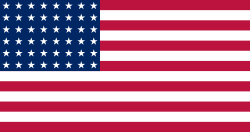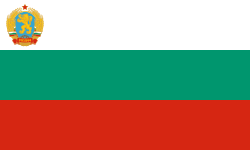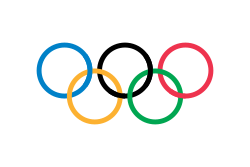Iran i olympiska sommarspelen 1956
| ||||||
| Kommitté | Irans Olympiska Kommitté | |||||
|---|---|---|---|---|---|---|
| Olympiska sommarspelen 1956 i Melbourne | ||||||
| Deltagare | 17 deltagare i 3 grenar | |||||
| Fanbärare | Mahmoud Namdjou | |||||
| ||||||
| ||||||
| Iran i olympiska sommarspelen | ||||||
| 1900 • 1904-1936 • 1948 • 1952 • 1956 • 1960 • 1964 • 1968 • 1972 • 1976 • 1980 • 1984 • 1988 • 1992 • 1996 • 2000 • 2004 • 2008 • 2012 • 2016 • 2020 | ||||||
| Iran i olympiska vinterspelen | ||||||
| 1956 • 1960 • 1964 • 1968 • 1972 • 1976 • 1980-1994 • 1998 • 2002 • 2006 • 2010 • 2014 • 2018 • 2022 | ||||||
Iran deltog i de olympiska sommarspelen 1956 i Melbourne. Landet ställde upp med en trupp bestående av 17 deltagare, samtliga män, vilka deltog i 17 tävlingar i tre sporter. Iran slutade på 14:e plats i medaljligan, med två guldmedaljer och fem medaljer totalt.[1]
Medaljer
 Guld
Guld
- Emam-Ali Habibi - Brottning, Lättvikt, fristil
- Gholamreza Takhti - Brottning, Lätt tungvikt, fristil
 Silver
Silver
- Mohammad Ali Khojastehpour - Brottning, Flugvikt, fristil
- Mehdi Yaghoubi - Brottning, Bantamvikt, fristil
 Brons
Brons
- Mahmoud Namdjou - Tyngdlyftning, 56 kg
Brottning
- Fristil[2]
| Idrottare | Gren | Omgång 1 | Omgång 2 | Omgång 3 | Omgång 4 | Omgång 5 | Sista omgången | |
|---|---|---|---|---|---|---|---|---|
| Motståndare Resultat | Motståndare Resultat | Motståndare Resultat | Motståndare Resultat | Motståndare Resultat | Motståndare Resultat | Plats | ||
| Mohammad Ali Khojastehpour | 52 kg | bye | Vinst 3-0 | Vinst 3-0 | Vinst 3-0 | i.u. | Vinst 3-0 Förlust genom fall | |
| Mehdi Yaghoubi | 57 kg | Vinst 3-0 | Vinst genom fall | Vinst genom fall | Förlust 1-2 | Vinst 3-0 | i.u. | |
| Nasser Givehchi | 62 kg | Vinst 3-0 | Vinst genom fall | Förlust 1-2 | Förlust 0-3 | i.u. | Gick inte vidare | 6 |
| Emam-Ali Habibi | 67 kg | Vinst genom fall | Vinst 3-0 | Vinst 3-0 | Vinst 3-0 | Vinst 3-0 | Vinst genom fall | |
| Nabi Sorouri | 73 kg | Vinst genom fall | Förlust 0-3 | Vinst 3-0 | Vinst 3-0 | i.u. | Gick inte vidare | 4 |
| Abbas Zandi | 79 kg | Vinst 3-0 | bye | Förlust 0-3 | Förlust genom fall | Gick inte vidare | 7 | |
| Gholamreza Takhti | 87 kg | Vinst genom fall | Vinst genom fall | Vinst genom fall | Vinst genom fall | i.u. | Vinst 3-0 Vinst 3-0 | |
| Hussain Noori | +87 kg | Förlust 0-3 | Vinst 3-0 | Förlust genom fall | Gick inte vidare | i.u. | Gick inte vidare | 9 |
Friidrott
- Maraton[3]
- Ali Baghbanbashi
- Tid: slutförde inte loppet
- Tiokamp[4]
| Idrottare | Gren | 100 m | LJ | SP | HJ | 400 m | 110H | DT | PV | JT | 1500 m | Final | Placering |
|---|---|---|---|---|---|---|---|---|---|---|---|---|---|
| Nadjmeddin Farabi | Resultat | 12.1 | 6.25 | 11.31 | 1.70 | 52.3 | 17.4 | 28.73 | 3.30 | 41.23 | 4:24.8 | 5103 | 12 |
| Poäng | 572 | 575 | 524 | 656 | 684 | 372 | 347 | 438 | 375 | 560 |
Tyngdlyftning
Sju deltagare representerade Iran i tyngdlyftningen.[5]
| Idrottare | Gren | Press | Ryck | Stöt | Total | Placering |
|---|---|---|---|---|---|---|
| Mahmoud Namdjou | 56 kg | 100,0 | 102,5 | 130,0 | 332,5 | |
| Hussain Zarrini | 60 kg | 92,5 | 92,5 | 120,0 | 305,0 | 13 |
| Henrik Tamraz | 67,5 kg | 115,0 | 105,0 | 145,0 | 365,0 | 5 |
| Ibrahim Payrovi | 75 kg | 107,5 | 117,5 | 147,5 | 372,5 | 7 |
| Jalal Mansouri | 82,5 kg | 132,5 | 122,5 | 162,5 | 417,5 | 4 |
| Mohammad Hassan Rahnavardi | 90 kg | 140,0 | 127,5 | 157,5 | 425,0 | 4 |
| Firouz Pojhan | +90 kg | 147,5 | 132,5 | 175,0 | 450,0 | 4 |
Källor
- ^ Iran at the 1956 Melbourne Summer Games Arkiverad 14 september 2011 hämtat från the Wayback Machine.. Sports Reference. Läst 7 februari 2016.
- ^ The Organizing Committee of the XVI Olympiad (1958) (PDF). The Official Report of the Organizing Committee for the Games of the XVI Olympiad Melbourne1956. Melbourne, Australien: W. M. Houston, Government Printer. sid. 658-673. http://la84foundation.org/6oic/OfficialReports/1956/OR1956.pdf. Läst 7 februari 2016 Arkiverad 7 februari 2012 hämtat från the Wayback Machine.
- ^ The Organizing Committee of the XVI Olympiad (1958) (PDF). The Official Report of the Organizing Committee for the Games of the XVI Olympiad Melbourne1956. Melbourne, Australien: W. M. Houston, Government Printer. sid. 301-307. http://la84foundation.org/6oic/OfficialReports/1956/OR1956.pdf. Läst 7 februari 2016 Arkiverad 7 februari 2012 hämtat från the Wayback Machine.
- ^ The Organizing Committee of the XVI Olympiad (1958) (PDF). The Official Report of the Organizing Committee for the Games of the XVI Olympiad Melbourne1956. Melbourne, Australien: W. M. Houston, Government Printer. sid. 342. http://la84foundation.org/6oic/OfficialReports/1956/OR1956.pdf. Läst 7 februari 2016 Arkiverad 7 februari 2012 hämtat från the Wayback Machine.
- ^ The Organizing Committee of the XVI Olympiad (1958) (PDF). The Official Report of the Organizing Committee for the Games of the XVI Olympiad Melbourne1956. Melbourne, Australien: W. M. Houston, Government Printer. sid. 634-646. http://la84foundation.org/6oic/OfficialReports/1956/OR1956.pdf. Läst 7 februari 2016 Arkiverad 7 februari 2012 hämtat från the Wayback Machine.
| ||||||||||
| ||||||||||||||||||||
Media som används på denna webbplats
State Flag of Iran, 1933-1964
Författare/Upphovsman: B1mbo, Licens: CC BY-SA 2.5
Drawing of a gold medal, based on Olympic rings.svg.
Författare/Upphovsman: B1mbo, Licens: CC BY-SA 2.5
Draw of a silver medal, based in Olympic rings.svg.
- The joining of the rings is not correct drawn.
Författare/Upphovsman: B1mbo, Licens: CC BY-SA 2.5
Drawing of a bronze medal, based on Olympic rings.svg.
US Flag with 48 stars. In use for 47 years from July 4, 1912, to July 3, 1959.
Variant version of a flag of Japan, used between January 27, 1870 and August 13, 1999 (aspect ratio 7:10).
Variant version of a flag of Japan, used between January 27, 1870 and August 13, 1999 (aspect ratio 7:10).
An icon that represents a silver medal
Flag of South Korea (1949-1984)
Flag of South Korea (1949-1984)
Flag of South Africa, used between 1928 and 1982. It is identical to the 1982 to 1994 version except that the shade of blue is darker. It is also known as the "Oranje-Blanje-Blou".
Flag of South Africa, used between 1928 and 1982. It is identical to the 1982 to 1994 version except that the shade of blue is darker. It is also known as the "Oranje-Blanje-Blou".
An icon that represents a gold medal
Författare/Upphovsman: Scroch, Licens: CC BY-SA 4.0
National Flag of the People's Republic of Bulgaria (1948-1968). Tha flag has got the coat-of-arms from 1948
The Canadian Red Ensign used between 1921 and 1957.
This image has compared for accuracy (mainly colors) using an image from World Statesmen. The only change is making the maple leaves green from red. This image has compared for accuracy (mainly colors) using an image from World Statesmen. The most recent version of this image has changed the harp into one with a female figure; see [http://flagspot.net/flags/ca-1921.html FOTW
The Canadian Red Ensign used between 1921 and 1957.
This image has compared for accuracy (mainly colors) using an image from World Statesmen. The only change is making the maple leaves green from red. This image has compared for accuracy (mainly colors) using an image from World Statesmen. The most recent version of this image has changed the harp into one with a female figure; see [http://flagspot.net/flags/ca-1921.html FOTW
An icon that represents a bronze medal
Olympic Movement flag
Proportions 2:3, created 1913, adopted 1914, first used 1920.
- Colors as per http://fairspielen.de/wp-content/uploads/2015/09/Annexe-3-Olympism_and_the_Olympic_Symbol_-_Principles_and_Usages_Guide-1.pdf
- blue: PMS 3005C
- yellow: PMS 137C
- black: PMS 426C
- green: PMS 355C
- red: PMS 192C
- Dimensions of the rings taken from http://fairspielen.de/wp-content/uploads/2015/09/Annexe-3-Olympism_and_the_Olympic_Symbol_-_Principles_and_Usages_Guide-1.pdf
Författare/Upphovsman: Scroch, Licens: CC BY-SA 4.0
National Flag of the People's Republic of Bulgaria (1948-1968). Tha flag has got the coat-of-arms from 1948
State Flag of Iran, 1933-1964
Flag of Hungary from mid/late 1946 to 20 August 1949 and from 12 November 1956 to 23 May 1957.






















